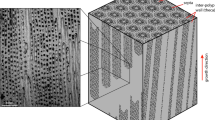Abstract
Initiation of coral-skeleton formation was studied in the reef-coral Pocillopora damicornis Lamarck. Observations were made on sequential skeletal growth stages of newly settled planula larvae during the first 22 days following settling onto glass microscope slides. Techniques used include phase light microscopy, scanning and transmission electron microscopy, and powder X-ray and selected area electron micro-diffraction. Formation of the skeleton is initiated immediately on settling of the larva. The primary calcareous elements are of two types — flattened spherulitic platelets, and smaller rod-like granules. Rudimentary primary septa are clearly defined within 6 h after settling. Fusion of the primary calcareous elements results in the formation of the larval basal disc within 48 to 72 h. With transmission electron microscopy, this basal disc is found to differ from subsequent adult calcification in (1) considerably lesser degree of mineralization, (2) smaller crystal size, (3) more random orientation of the crystals, and (4) the presence of trace amounts of calcite in addition to aragonite. The basal disc with its septal rudiments constitutes a true larval skeleton, differing in morphology, micro-architecture, and crystal type from the fibrous growth characterizing the adult skeleton.
Similar content being viewed by others
Literature Cited
Abe, N.: Post-larval development of the coral Fungia actiniformis var. palawensis Doderlein. Palao trop. biol. Stn Stud. 1, 73–93 (1937).
Atoda, K.: The larva and postlarval development of some reef-building corals. I. Pocillopora damicornis cespitosa (Dana). Scient. Rep. Tôhoku Univ. (4th Ser. Biol.) 18, 24–47 (1947).
Barnes, D. J.: Coral skeletons: an explanation of their growth and structure. Science, N.Y. 170 1305–1308 (1970).
Barnes, D. J.: A study of growth, structure and form in modern coral skeletons. Ph. D. dissertation, University of Newcastle Upon Tyne 1971.
Bryan, W. H. and D. Hill: Spherulitic crystallization as a mechanism of skeletal growth in the hexacorals. Proc. R. Soc. Qd 52, 78–91 (1941).
Duerden, J. E.: Recent results on the morphology and development of coral polyps. Smithson. misc. Collns 47, 93–111 (1904).
Goreau, T. F.: The physiology of skeleton formation in corals. I. A method for measuring the rate of calcium deposition by corals under different conditions. Biol. Bull. mar. biol. Lab., Woods Hole 116, 59–75 (1959).
Harrigan, J. F.: Behavior of the planula larva of the sceleractinian coral Pocillopora damicornis (L.). Am. Zool. 12, p. 723 (1972).
Kawaguti, S. and K. Sato: Electron microscopy on the polyp of staghorn corals with special reference to its skeleton formation. Biol. J. Okayama Univ. 14, 87–98 (1968).
Kennedy, W. J., J. D. Taylor and A. Hall: Environmental and biological controls on bivalve shell mineralogy. Biol. Rev. 44, 499–530 (1969).
Muscatine, L. and E. Cernichiari: Assimilation of photosynthetic products of zooxanthellae by a reef coral. Biol. Bull. mar. biol. Lab., Woods Hole 137, 506–523 (1969).
National Bureau of Standards: Tables for conversion of X-ray diffraction angles to interplanar spacings. Appl. Math. Ser. 10 (1950).
Ogilvie, M. M.: Microscopic and systematic study of madreporarian types of corals. Phil. Trans. R. Soc. (Ser. B) 187, 83–345 (1897).
Picken, L.: The organization of cells, 629 pp. Oxford: University Press 1960.
Reed, S. A.: Techniques for raising the planula larvae and newly settled polyps of Pocillopora damicornis. In: Experimental coelenterate biology, pp 66–72. Ed. by H. M. Lenhoff, L. Muscatine and L. V. Davis. Honolulu: University of Hawaii Press 1971.
Siegel, F. R.: Scleractinian corals: strontium and aragonite. Why? In: Caribb. geol. Confer. (V: Margarita, Venezuela, 1971). (In press). (1973).
Sorauf, J. E.: Microstructure an formation of dissepiments in the skeleton of the recent Scleractinia (hexacorals). ForschBer. Biomineral. Akad. Wiss. Lit. Mainz 2, 1–22 (1970).
Stephenson, T. A.: Development and the formation of colonies in Pocillopora and Porites. Part I. Scient. Rep. Gt Barrier Reef Exped. 3, 113–134 (1931).
Vahl, J.: Sublichtmikroskopische Untersuchungen der kristallinen Grundbauelemente und der matrix Beziehung zwischen Weichkörper und Skelett an Caryophyllia Lamarck 1801. Z. Morph. Ökol. Tiere 56, 21–38 (1966).
Vandermeulen, J. H.: Studies on reef corals: II — fine structure of planktonic planula larva epidermis. Tissue Cell (1973a).
Vandermeulen, J. H.: Studies on reef corals: III — Fine structural changes in larva epidermis during settling and calcification. Tissue Cell (1973b). (In preparation).
Vandermeulen, J. H. and L. Muscatine: Influence of symbiotic algae on calcification in reef coral: critique and progress report. In: Symbiosis in the sea, Vol. II. Ed. by W. B. Vernberg and F. J. Vernberg. University of South Carolina Press. (1973). (In press).
Vaughan, T. W. and J. W. Wells: Revision of the suborders, families, and genera of the Scleractinia. Spec. Pap. geol. Soc. Am. 44, 1–363 (1943).
Von Heider, A.: Die Gattung Cladocora Ehrenberg. Sber. Akad. Wiss. Wien (1) 84, 634–667 (1882).
Von Koch, G.: Über die Entwicklung des Kalkskelettes von Asteroides calycularis und dessen morphologische Bedeutung. Mitt. zool. Stn Neapel 3, 284–292 (1882).
Wainwright, S. A.: Skeletal organization in the coral, Pocillopora damicornis. Q. Jl microsc. Sci. 104, 169–183 (1963).
— Studies on the mineral phase of coral skeleton. Expl Cell Res. 34, 213–230 (1964).
Wise, S. W., Jr.: Organization and formation of fasciculi in the skeletons of seleractinian corals. Bull. geol. Soc. Am. (Abstr.) 7, p. 241 (1969).
—: Scleractinian coral exoskeletons: surface microarchitecture and attachment scar patterns. Science, N.Y. 169, 978–980 (1970).
Young, S. D.: Organic material from scleractinian coral skeletons. I. Variation in composition between several species. Comp. Biochem. Physiol. 40 B, 113–120 (1971).
—: Calcification and synthesis of skeletal organic material in the coral, Pocillopora damicornis (L.). Comp. Biochem. Physiol. 44A, 669–672 (1973).
—, J. D. O'Connor and L. Muscatine: Organic material from scleractinian coral skeletons. II. Incorporation of 14C into protein, chitin and lipid. Comp. Biochem. Physiol. 40B, 945–958 (1971).
Author information
Authors and Affiliations
Additional information
Communicated by J. Bunt, Miami
Contribution 419, Hawaii Institute of Marine Biology, University of Hawaii.
Rights and permissions
About this article
Cite this article
Vandermeulen, J.H., Watabe, N. Studies on reef corals. I. Skeleton formation by newly settled planula larva of Pocillopora damicornis . Mar. Biol. 23, 47–57 (1973). https://doi.org/10.1007/BF00394111
Accepted:
Issue Date:
DOI: https://doi.org/10.1007/BF00394111




